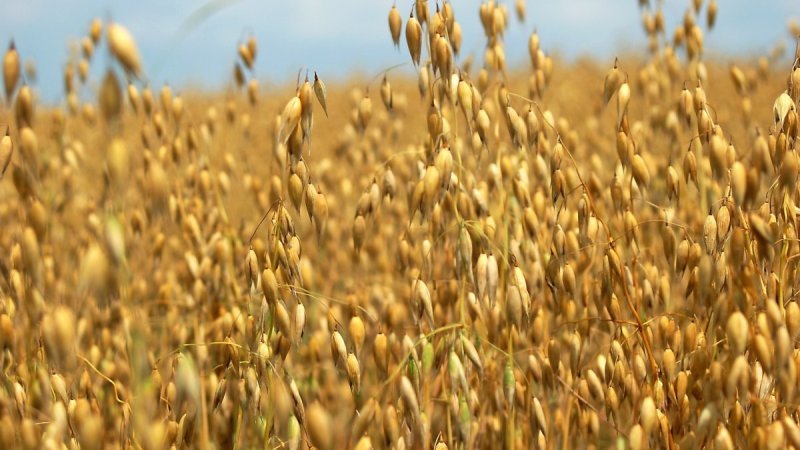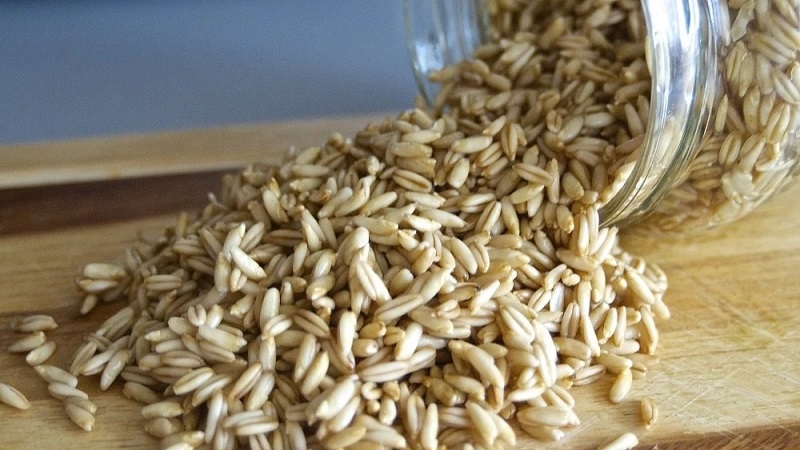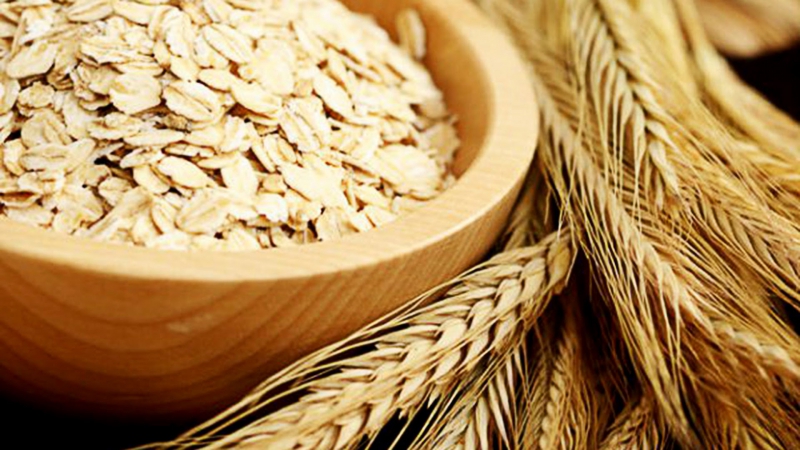Why oats are useful for diabetes mellitus and how to use it correctly with maximum benefit
People with diabetes pay great attention to their diet. A properly selected diet significantly improves their quality of life. And the choice of products is not the task of doctors, but of the person himself.
The leading place in the diet of a diabetic is taken by cereals, in particular oats in various forms. It can be decoctions, jelly, porridge or sprouted grain. Let us dwell in more detail on the benefits and dangers of oats, as well as the methods of its preparation and use for different types of diabetes.
The content of the article
The benefits and harms of oats for diabetes
To cure the disease, to live long, rich and happy, maintaining normal blood glucose levels is the task of the diabetic himself first of all. Eating well with oats included in your daily diet will help you achieve this. Let us examine what is included in the grain.

Chemical composition
The chemical composition of dry oat grains, from which cereals, oatmeal, flour and a special coffee drink are made, per 100 grams of the edible part of the product is as follows:
- protein - 16.9 g;
- fat - 6.9 g;
- carbohydrates (starch and sugars) - 55.67 g;
- dietary fiber - 10.6 g;
- ash - 1.72 g.
Macronutrient content:
- sodium - 2 mg;
- potassium - 429 mg;
- calcium - 54 mg;
- magnesium - 177 mg;
- phosphorus - 523 mg.
Microelement content:
- iron - 4.72 mg;
- manganese - 4.92 mg;
- copper - 626 mcg;
- zinc - 3.97 mg.
Vitamin content:
- B1 - 0.763 mg;
- B2 - 0.139 mg;
- B5 - 1.349 mg;
- B6 - 0.119 mg;
- B9 - 56 mcg;
- PP - 0.961 mg.
In addition, the composition of dry oat grain contains essential amino acids (arginine, leucine, valine and others) - about 7.3 g; nonessential amino acids (glutamic acid, glycine, etc.) - 9.55 g; saturated, monounsaturated and polyunsaturated fatty acids omega-3 - 0.111 g and omega-6 - 2.424 g.
KBZHU of different types of oats
The calorie content of oats depends on its variety and method of preparation. For example, 100 g of dry grain contains 389 kcal, and the calorie content of 100 g of Vita oats is only 250 kcal. The lowest-calorie oat products are water-cooked bran (40 kcal) and long-cooked oatmeal (62 kcal).
Oatmeal on water contains only 88 kcal per 100 g. Its composition: 3 g of protein, 1.7 g of fat and 15 g of carbohydrates.
In porridge cooked in milk, the content will be as follows:
- calorie content - 102 kcal;
- proteins - 3.2 g;
- fats - 1.7 g;
- carbohydrates - 14.2 g.
As you can see, the calorie content increases slightly due to milk.
Glycemic index
When forming a diabetic's menu, it is important to select foods according to the glycemic index (GI).
GI is a measure of the rate at which glucose enters the body after eating a food. Oatmeal is a very healthy1 GI product. Its indicator is 55 (average position in the range of different products). This speaks in favor of including oat products in the diabetic's menu. Especially with type 2 diabetes, when it is important not to gain weight.
Can you eat oats for type 1 and type 2 diabetes?
Since the immunity of type 1 and type 2 diabetic is reduced, this causes frequent infectious diseases. To maintain the body's defenses, oat products are suitable due to the content of a large amount of various vitamins.

Points for and against
The following arguments stand for the use of oat dishes:
- High content of vitamins, amino acids, micro - and macronutrients.
- The content of the insulin analogue - inulin in the product.
- Low glycemic index of the product.
- Oats are diuretic and diaphoretic.
- Normalizes the function of the nervous system.
- It has a beneficial effect on the functioning of the gastrointestinal tract.
- It has a general strengthening effect on the entire body.
There are practically no contraindications for the use of this product. It should be eaten with caution for people with gallbladder disease and kidney failure.
Diet rules for diabetes
There are certain rules for eating oats. with diabetes. These include the following guidelines:
- it is better to cook dishes from long-boiled oats;
- add a minimum of sweeteners (syrup, honey, jam, etc.);
- to prepare porridge, do not use fat milk and do not add a lot of butter.
Usage rates
Oats provide the body with a long-lasting energy boost thanks to its high proportion of complex carbohydrates, protein and fat. Vegetable fiber keeps you feeling full for a long time. Experts advise taking oatmeal for breakfast once every 2-3 days. But you shouldn't eat it every day, as oatmeal contains phytic acid, which flushes calcium out of bone tissue.

In what form is it better to eat oats for diabetes
There are many oat dishes. Each of them is useful in its own way.
For type 2 diabetes, it is recommended use oatmeal for breakfast, salads with sprouted grains.
Several suitable recipes:
- Sprout oats soaking the grains in water until sprouts appear. These sprouts are used in salads or added to yoghurts. When consumed daily, they have the ability to normalize blood sugar.
- Kissel - a tasty, healthy and simple dish. To do this, the grains are ground in a coffee grinder to the state of flour and jelly is cooked from it in water.
- Oat bran - a simple and excellent treatment for diabetes. Starting from one teaspoon, the product is diluted in water and drunk. Gradually, within a week, the amount of bran is tripled.
- Porridge it is best to cook from those flakes that have been boiled for more than 5 minutes. It is even more useful to use oats in grains: soak it in the evening, and in the morning boil it in water or low-fat milk.
Using oats for diabetes
For the treatment of diabetes, folk recipes for preparing oats, which have come down to us through more than one generation, are also used. They prepare simply. Decoctions and infusions are considered the most effective. Consider how to brew oats for treatment.
Folk recipes
A decoction of whole unpeeled grains is prepared at the rate of 1 cup of grains for 2-3 liters of water. Pour oats into a saucepan, pour clean water, bring to a boil and reduce to the quietest fire. Close with a lid and simmer for an hour. Filter, cool and store in the refrigerator.
The infusion is made in the evening, ideally in a thermos. Pour 100 g of unrefined grain with boiled water (0.75 l) and, covering with a lid, leave to languish until morning. Strain and drink in the morning.
How to brew properly to lower blood sugar
There are several recipes for brewing oats. Take whole grains or 100-150 g crushed in a meat grinder, pour 1 liter of hot water, cook for 30-40 minutes over a quiet fire. Filtered - the drink is ready.
Treatment regimens
The scheme for using medicinal decoctions and infusions is simple. For four weeks, you should drink prepared drinks, 0.5-1 glass, 15-20 minutes before meals.
Contraindications
There are several diseases in which it is not worth getting carried away with oats even to lower blood sugar. Of the two evils, you have to choose the lesser, so it's better not to risk it. Despite the good reviews for cleansing the body with oat broths, not everyone can drink them.
Contraindications for taking oat products include:
- stones in the gallbladder or lack thereof;
- renal failure;
- severe cardiovascular disease;
- liver pathology.
Reviews

Reviews show that diabetics are increasingly giving preference to whole grain meals rather than “quick” cereals.
Victoria, 38 years old: “I have type 2 diabetes. Several years ago, I read in an old newspaper about the benefits of a decoction of oats. It turned out that it is not only useful, but also tastes good, similar to sweetened tea. I take unpeeled oats, grind it in a coffee grinder and pour a couple of tablespoons with boiling water in a thermos. You can drink in 3-4 hours. In summer you shouldn't make a lot of drink for future use, it will ferment quickly.
Maria, 55 years old: “I discovered sprouted oats for myself. Delicious salads are obtained from a mixture of different grains! Do not be lazy for yourself, buy clean, unprocessed oats, green buckwheat, rinse, pour into a baking sheet on a towel, cover, moisten. Add filtered water every day. In 3-5 days the sprouts can be used. "
Read also:
Whether or not eggplant can be used for type 2 diabetes: benefits and harms, recipes.
Why pumpkin is useful for type 1 and type 2 diabetes and how to cook it in the most delicious ways.
Whether or not corn is possible for type 2 diabetes: harm and benefit, consumption rates.
Conclusion
Oats and oats-based foods help fight type 1 and type 2 diabetes. A balanced menu must include oats in different forms. Such nutrition gives excellent results in correcting blood glucose levels. But remember that it is difficult to achieve complete remission without the use of drugs.
Be sure to follow the advice of an endocrinologist - treat diabetes by combining medications and folk remedies.